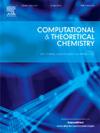神经毒剂醇解反应机理的理论研究:塔苯与甲醇的反应
IF 3
3区 化学
Q3 CHEMISTRY, PHYSICAL
引用次数: 0
摘要
采用B3LYP/ 6-311 ++G(d,p)、m06 - 2x / 6-311 ++G(d,p)和MP2/6-311 ++G(d,p)水平对他本醇解机理进行了系统研究。从理论上考察了三种可能的反应过程,即P-CN、P-N (CH3)2和P-OEt的分解途径。为了探索额外的甲醇和水的影响,甲醇催化和水催化的醇解进行了广泛的评估。此外,我们还在m06 - 2x / 6-311 ++G(d,p)水平上进行CPCM模型,考虑了水中溶剂的影响。我们的预测结果令人信服地表明,能量明显较低的逐步机制比协同机制更为突出,最优选的机制似乎是P-CN解理通道的逐步途径。此外,我们的理论结果清楚地表明,甲醇辅助和水辅助醇解比直接醇解更容易发生。溶剂效应对反应机理影响不显著。我们的结果无疑为神经毒剂的降解提供了有价值的信息。本文章由计算机程序翻译,如有差异,请以英文原文为准。

Theoretical investigation on the alcoholysis reaction mechanism of nerve agents: The reaction of tabun with methanol
The alcoholysis mechanism for tabun has been systematically studied by using B3LYP/6–311++G(d,p), M06-2×/6–311++G(d,p) and MP2/6–311++G(d,p) levels. Three plausible reaction processes, the P–CN, P–N(CH3)2 and P–OEt disintegration pathways involving the concerted and stepwise channels are theoretically examined. To explore the effect of additional methanol and water, methanol-catalyzed and water-catalyzed alcoholysis are extensively assessed. Additionally, we also consider the effect of solvent in water by performing CPCM model at M06-2×/6–311++G(d,p) level. The results of our predictions show convincingly that the stepwise mechanism with obviously lower energy is more prominent than the concerted one and the most preferred mechanism seems to be the stepwise pathway of the P–CN cleavage channel. Moreover, our theoretical results clearly demonstrate the methanol-assisted and water-assisted alcoholysis are more easier to occur than the direct alcoholysis. Solvent effect does not have remarkable effect on the reaction mechanism. Our results certainly provide valuable information for the degradation of nerve agents.
求助全文
通过发布文献求助,成功后即可免费获取论文全文。
去求助
来源期刊

Computational and Theoretical Chemistry
CHEMISTRY, PHYSICAL-
CiteScore
4.20
自引率
10.70%
发文量
331
审稿时长
31 days
期刊介绍:
Computational and Theoretical Chemistry publishes high quality, original reports of significance in computational and theoretical chemistry including those that deal with problems of structure, properties, energetics, weak interactions, reaction mechanisms, catalysis, and reaction rates involving atoms, molecules, clusters, surfaces, and bulk matter.
 求助内容:
求助内容: 应助结果提醒方式:
应助结果提醒方式:


